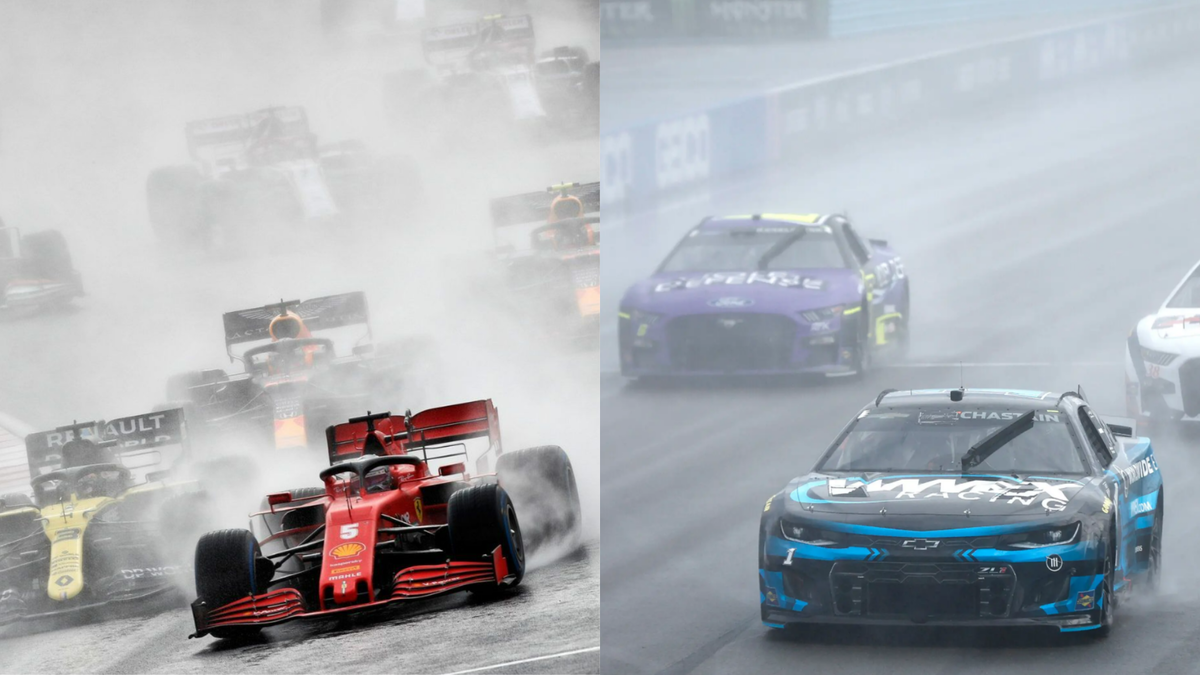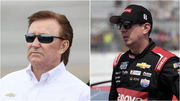

The conversation comparing NASCAR and Formula One often revolves around speed, strategy, and spectacle, but this week, the debate shifted to weather resilience. At the 2025 Brickyard 400, dramatic late-race rain at Indianapolis Motor Speedway triggered a brief delay, but NASCAR swiftly deployed high-powered drying technology and kept the action alive. In stark contrast, the Belgian Grand Prix at Spa-Francorchamps faced torrential rain that forced Formula One into a lengthy hour-and-20-minute delay before the race even began. The difference highlighted NASCAR’s determination to race through the elements versus F1’s more cautious approach to wet conditions.
Watch What’s Trending Now!
In NASCAR, rain delays are handled with precision. The star of the show is the Air Titan system, a compressed air setup mounted on pickup trucks that blasts water off the racing surface and onto the apron. There, vacuum wipes finish the job. Behind them, traditional jet dryers blow hot air to clear any remaining moisture. These tools have cut drying time from hours to sometimes under two. The system has transformed rain response at tracks like Indianapolis, where 19 Toyota Tundra units, 10 drivers, and multiple vacuums worked together to restore racing conditions mid-race during the 2025 Brickyard 400.
ADVERTISEMENT
NASCAR’s rain response shines as F1 faces delays
Over a decade ago, NASCAR began investing in advanced track-drying technology after rain-plagued races like the 2013 Daytona 500 exposed the limits of jet dryers. Determined to make drying short tracks like Martinsville a 15-minute reality, then-chairman Brian France pledged a greener, more carbon-conscious approach. Since then, NASCAR has doubled down, streamlining infrastructure and deploying innovations like the Air Titan system to dramatically reduce rain delays. The payoff? More green-flag racing, fewer red-flag interruptions, and fans spending less time waiting and more time watching. Meanwhile, at Sunday’s Belgian Grand Prix, Formula 1’s response to rain was a sluggish truck crawling across the circuit; an image that felt more like a throwback than a solution.
Track drying is something that F1 could learn from NASCAR. https://t.co/8Ax9WSwH2M
— Bozi Tatarevic (@BoziTatarevic) July 27, 2025
Launched in 2013, NASCAR’s initiative to slash track-drying time by up to 80% marked a major leap in motorsport innovation. Conceived by then-chairman Brian France and developed over eight months by six project managers at the NASCAR Research and Development Center, the system aimed to eliminate lengthy rain delays, especially on short tracks like Martinsville.
ADVERTISEMENT
The technology uses high-powered compressed air to push water off the racing surface and onto the apron, where vacuum trucks quickly remove it. Behind them, five jet dryers follow to eliminate residual moisture, leaving the track race-ready. Two Air Titan units operate simultaneously, creeping around the circuit at just 4 to 5 mph, each assigned to dry half the track. According to NASCAR’s Senior VP of Racing Operations, Steve O’Donnell, a single pass is often sufficient to make the surface safe. For safety and logistics, race cars remain on pit road during the drying process, while large hoses connect the air compressors to their power sources, ensuring both efficiency and security.
At the 2025 Brickyard 400 at Indianapolis Motor Speedway, a late-race rain delay of approximately 20 minutes was swiftly handled thanks to these systems. The result? A dramatic double-overtime finish, not a stalled momentum or loss of daylight. For teams and fans alike, NASCAR’s weather protocols preserve the integrity of competition, even under wet skies.
ADVERTISEMENT
In contrast, Formula 1 does not deploy active track-drying systems. Instead, F1 relies on natural drainage, marshals with squeegees or sweepers, and occasionally the safety car or support vehicles to help disperse water. When conditions remain unsafe, particularly due to spray and poor visibility, the FIA opts for race delays or red flags, often leaving the circuit wet and waiting for the weather to improve rather than actively drying the surface.
Top Stories
Michael Jordan Brings NASCAR to Its Knees as Jim France’s Courtroom Collapse Triggers Settlement

Denny Hamlin Gloats as Jim France Forced to Eat His Words Against Rick Hendrick & Co.

“Shouldn’t Keep His Job”: Dale Earnhardt’s Long-Time Sponsor Demands Steve Phelps’ Ouster After Disgracing Richard Childress

Dale Jr. Shuts Down Michael Jordan & 23XI’s ‘NASCAR Monopoly’ Claims With Brutal Reality Check

Kyle Busch’s Future in Limbo As Richard Childress Admits Exit Plans Amid NASCAR on Sale Rumors

F1’s rain halt at Spa: could NASCAR’s way work?
The contrast couldn’t be sharper at the 2025 Belgian Grand Prix. Heavy rain hit Spa just as cars pulled onto the grid, triggering a formation lap behind the safety car. But with visibility severely compromised due to spray, drivers returned to the pit lane, prompting the FIA (Formula 1’s governing body) to red-flag the start. What followed was an 80-minute delay, during which only four laps ran under the safety car, a far cry from the uninterrupted action that fans expected.
ADVERTISEMENT
F1 teams criticized the delay, with Max Verstappen, the Dutch Red Bull Racing driver and reigning world champion, calling it overly cautious and questioning why the race couldn’t have started earlier. Others, including George Russell, British driver for Mercedes, and Charles Leclerc, Monegasque driver for Ferrari, praised the FIA’s safety-first decision, especially in light of Spa’s tragic past and the high-speed nature of sections like Eau Rouge, where spray at 200 mph can prove deadly.
Formula 1’s hesitation in rain isn’t just about technology, it’s rooted in a different culture of caution and legacy. While NASCAR has embraced machinery to maximize green-flag time, F1 has remained tethered to manual methods and weather waits. Yet, as fan expectations shift and delays grow more frustrating, the sport faces a new kind of pressure: adapting its identity to modern momentum. The question isn’t just whether active drying systems work, it’s whether Formula 1 is ready to rethink what racing through the rain really means.
ADVERTISEMENT
ADVERTISEMENT
ADVERTISEMENT
ADVERTISEMENT

